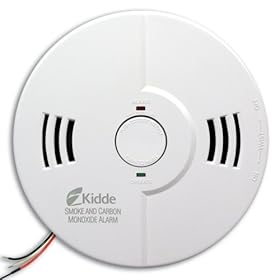 A co-worker at work subscribes to Consumer Reports and almost always consults them when he's making a buying decision. So last year, when he said that he bought new combination smoke/carbon monoxide detectors, I asked him which he chose. He said the Kidde Hardwire Combination Carbon Monoxide and Smoke Alarm with Battery Backup and Voice Warning was the one to get. Susan and I promptly purchased three, one for each floor in the house.
A co-worker at work subscribes to Consumer Reports and almost always consults them when he's making a buying decision. So last year, when he said that he bought new combination smoke/carbon monoxide detectors, I asked him which he chose. He said the Kidde Hardwire Combination Carbon Monoxide and Smoke Alarm with Battery Backup and Voice Warning was the one to get. Susan and I promptly purchased three, one for each floor in the house. That was a year ago, before we even moved in to the house. In the meantime, the old smoke detector that came with the house has been working fine. Sure, it was located right outside the bathroom and would go off after a hot shower, but it was still sensitive, right? Then, we had a hot day a few weeks ago, and the smoke detector thought our house was on fire. Time to actually install the smoke detectors. That was the project for the last two weekends.
There are a few factors that make these smoke/CO detectors so cool.
- They are hard-wired into the circuit breaker box.
- They have a battery backup in case the electricity ever goes out.
- They talk to each other. When one goes off, they all sound the alarm.
- They speak. When there is a fire, the alarm says "Fire," and when there is a carbon monoxide issue, it says "Carbon Monoxide." In an emergency, it is important to know what the problem is.
In Cook County, all electrical wiring in a house has to be run inside of metal conduit. So, to complete this project, I had to run conduit throughout the house. The hardest part was figuring out how to get the conduit from the basement to the attic. Turns out, in a brick house, there is just enough room between the brick and the frame to slide a ½ inch conduit pipe straight up to the attic. The (now obvious) thing I learned was that it is a bad idea to put any kind of connector behind the wall, because if the fishtape is going to have problems going through anything, it will be at the connector you can't access. Once I replaced that section of conduit with a single piece, the project wasn't all that daunting anymore.
And we'll all sleep better at night. Unless of course there is a fire or a carbon monoxide leak, in which case we'll all be waking up, regardless of where in the house we are sleeping!



No comments:
Post a Comment